Wearable App Development: Detailed Guide
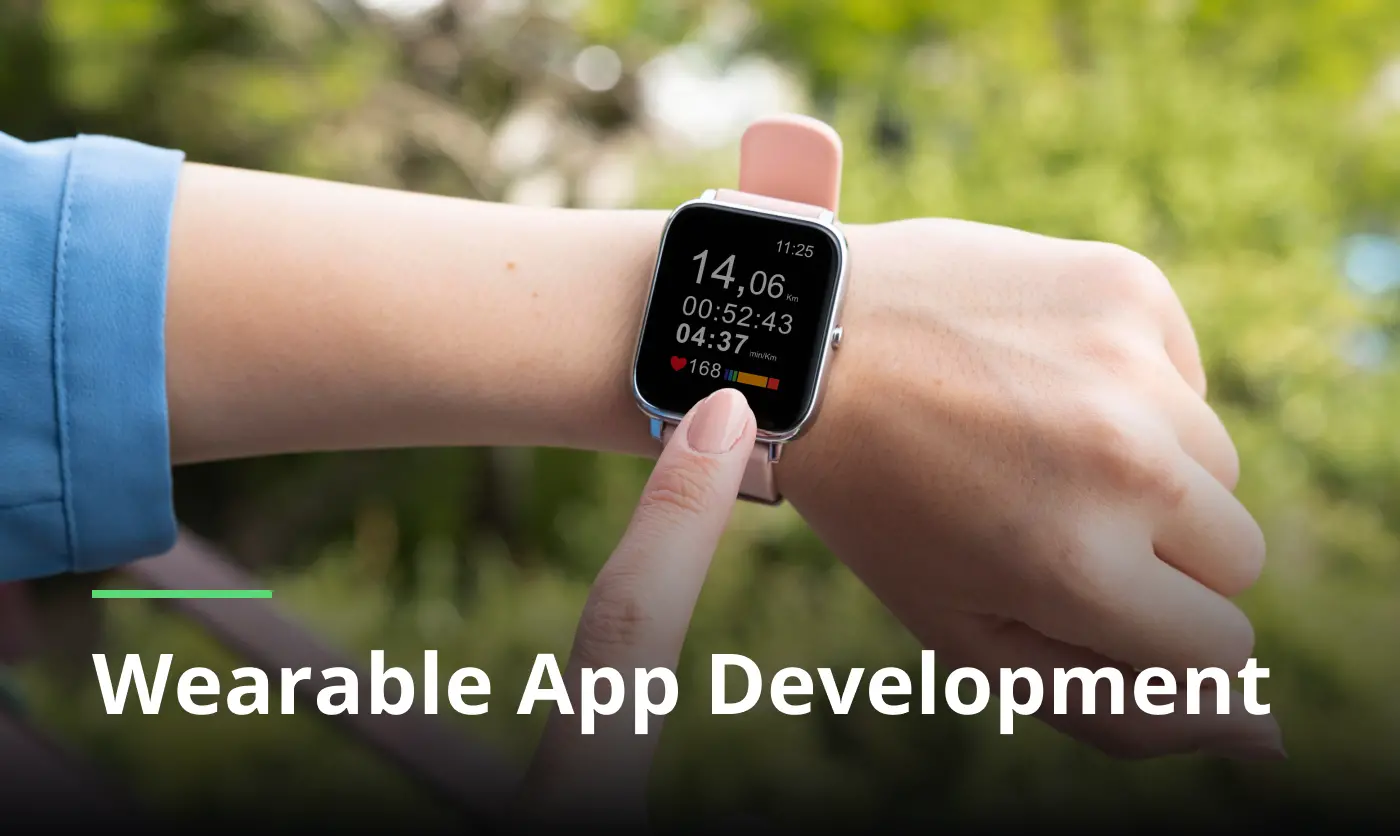
Wearable app development is on track for revolutionary innovation, thanks to the rapid rise of body-worn technology. Today, these devices are fundamental to daily routines, and their popularity has grown, driving a need for smart and secure apps. In this outline, we go through new trends, tech, and security considerations that developers should embrace when building top-tier apps for wearables.
Wearable devices app development is much more than just coding. So to build a well-rounded app, we should choose the best tech stack, focus on performance optimization, and make sure the app can integrate well across different devices.
Security and innovation need to go hand in hand in order to create a wearable app that makes a mark. Every wearable application relies on security features users trust to absorb sensitive data. Want to explore what is possible for your next wearable app? Reach out to us at Limeup to find out how we can support your project with our app creation service.
What is wearable app development?
App development for wearables is the process of crafting and producing applications made for wearable devices, like smartwatches, fitness trackers and augmented reality (AR) glasses. It had begun growing exponentially in 2014 when the Apple Watch and Fitbit rushed into the market, kicking off a new form of tech innovation.
It isn’t just about shrinking mobile apps down to fit on smaller screens when developing apps for wearables. Creating wearable apps that harness all the features devices have, such as heart rate monitoring, GPS tracking, and hands-free voice commands, since companies crafting wearables have to push the envelope.
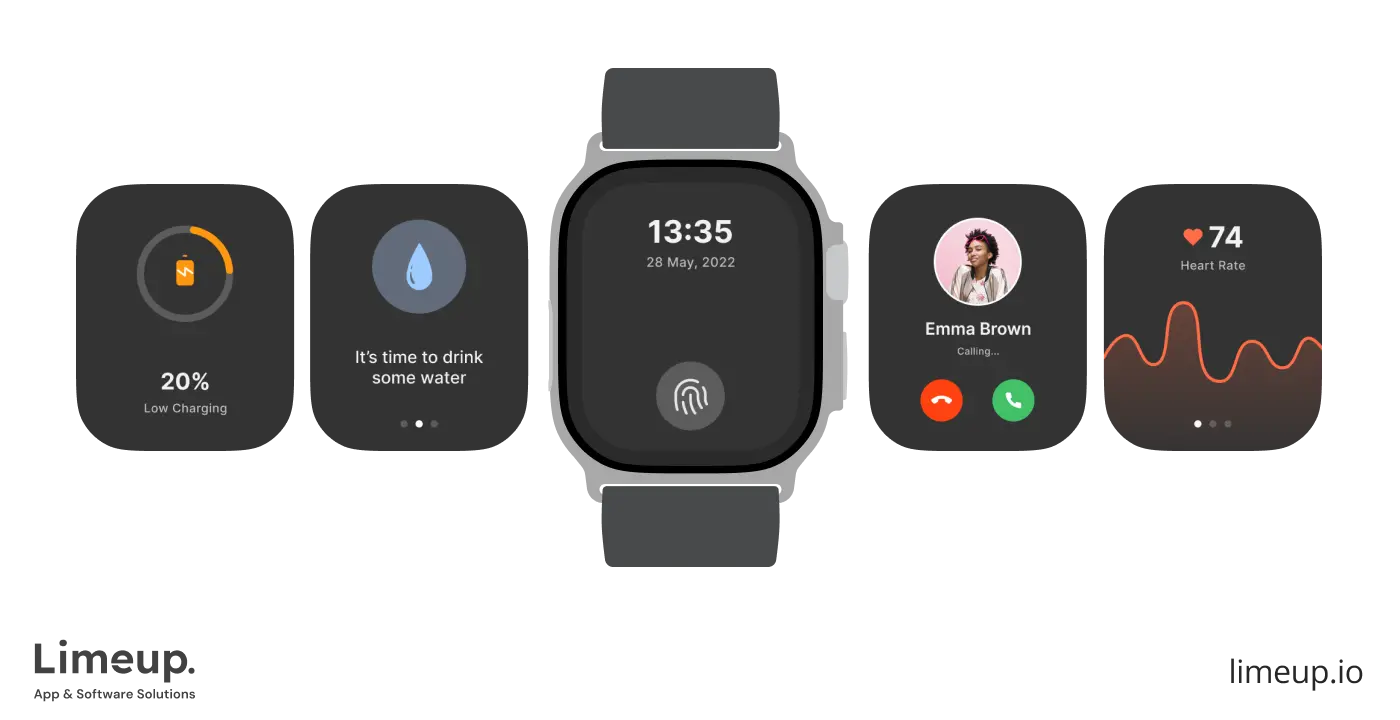
Developers have to lead the field and use pioneering tech stacks like Swift and Kotlin, together with APIs from industry titans like Samsung, Google, and Apple to create high-performing apps that operate efficiently on constrained resources.
The challenges aren’t limited to performance; sensitive personal data is handled by wearable devices. And to build airtight apps for GDPR, biometric authentication and data encryption among other such things. Augmented reality and AI are breaking new ground, and the successful development of wearable apps is now futuristic as well as secure, poised to lead the tech revolution throughout the 2020s and beyond.
Types of wearable applications
On-body apps are differentiated depending on the needs of users, and a skilled wearable device app development company recognizes the importance of tailoring solutions accordingly. There are primarily the following categories:
- Fitness and health trackers. Track your steps, heart rate, sleep trend and other health-related data.
- SmartWatch features. Manage notifications, quickly reply, play music and calendar reminders.
- AR (Augmented Reality) apps. Wearable glasses providing navigation, real time translation and head-up data.
- Industrial wearables. Make sure the safety checks are made, biometric checks are held and the professionals are given hands-free options.
- Entertainment and gaming. Develop motion sensor-based interactive entertainment and AR technology-based entertainment.
Such classifications present the wearable apps, which marry convenience with features that support specialized needs so they fit a wide array of lifestyles and industries.
Features for wearable device apps
The functionality of wearable apps depends on specific traits that enhance both usability and performance, areas where a skilled wearable devices app development company brings sharp focus. Notable specs are the following:
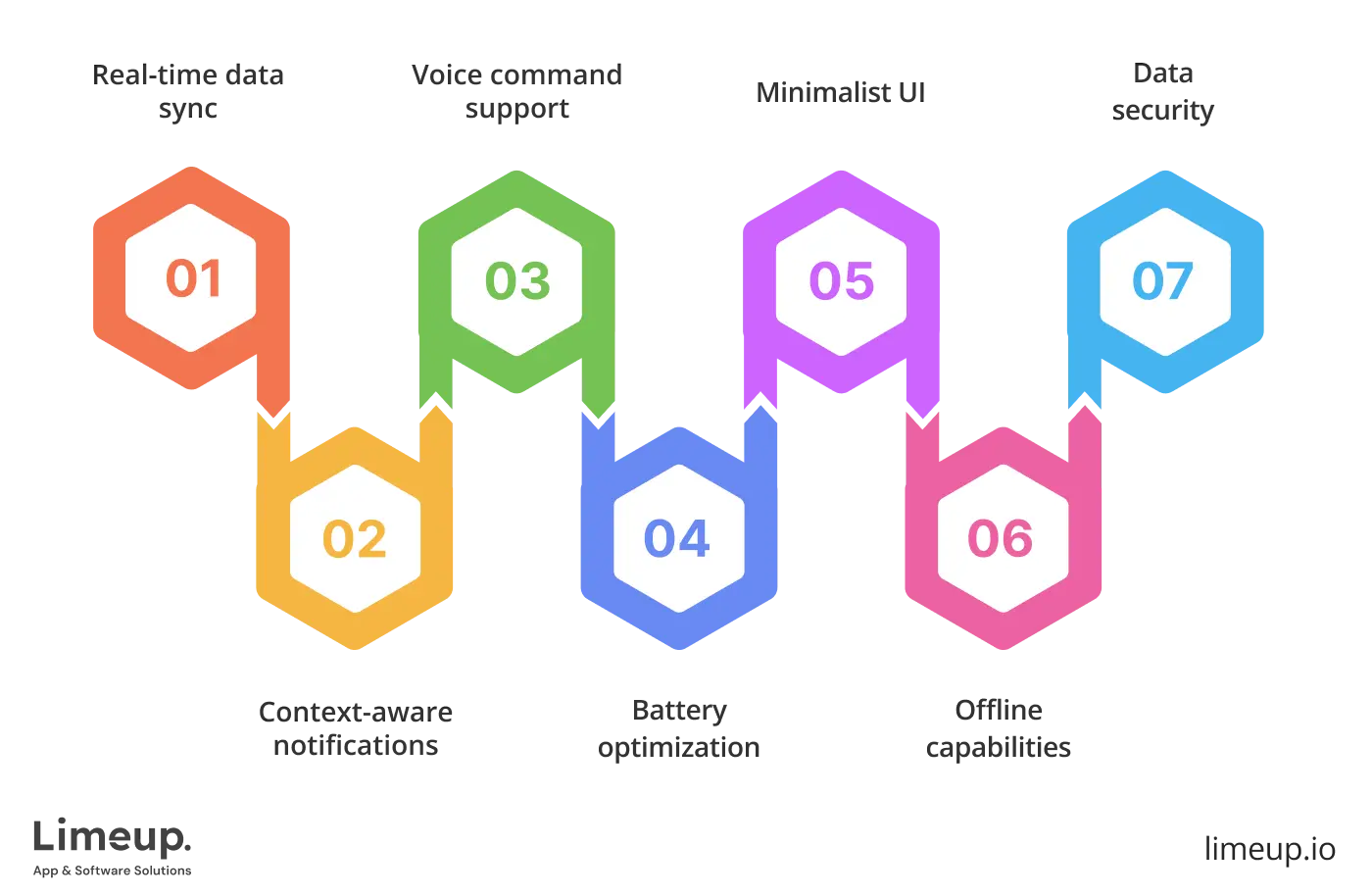
Real-time data sync. Constant and intimate communications with smartphones or cloud servers mean that users are continually provided with the latest details at their disposal.
Context-aware notifications. Intelligent Alerts push information based on relevance, making users conscious of the relevant information but not the attended information.
Voice command support. This facilitates the use of a device without the use of hands as it enables the person to use his/her voice in controlling his/her device readily, particularly during a time that requires him/her to perform the activity thoroughly such as during workouts or when travelling.
Battery optimization. Diligence in the use of power makes the gadget last longer without the ability of applications to shut down.
Minimalist UI. Efficient, easy to navigate, plain interfaces which are simple and easy to look at in a few seconds and are just right to be displayed on a small screen and to have quick responses.
Offline capabilities. Key features will be available offline so that they use it without an internet connection.
Data security. Sensitive personal data is secure and not exposed to abuse by use of strong encryption and privacy prevention policies.
With these combined traits, wearable apps achieve fluid and reliable performance optimized for small screens.
Industries that benefit from wearable technology
Wearables have revolutionized many industries in that they guarantee enhanced user engagement and increased productivity and safety. The impact of developing wearable app solutions is especially evident across these major sectors:

- Medical. A round-the-clock surveillance of patients and a distant diagnostic support by a medical app development company.
- Designing and processing. Increased safety protection of the workers and equipment tracking in real-time as well as streamlined workflows.
- Retail. Enhanced inventory management, together with customer experience through personal interactions.
- Sports. The Fitbit biometric tracking to analyse the performance and preventative sports injury plans.
- Education. The use of immersive AR devices and smart glasses in establishing a learning environment.
- Entertainment. Aiming at the wearable platforms is a variety of dynamic games and augmented reality content.
- Military and public safety. Sustainable communications with better on-screen awareness in the field.
Wearables are the digital backbone syncing people, processes, and performance across diverse industries.
How to create a wearable app: proven strategies
Breaking a wearable app creation into digestible steps can make it seem less daunting for creators. Wearable tech is hitting its stride and presents some of the biggest value to the market today, as the sector is projected to hit the massive $186.14 billion mark by 2030, a staggering 14.6% increase from 2023.
Now let’s dissect a few essential steps to creating a successful wearable app, as their development presents its own unique challenges and opportunities.
Step 1. Identify your goals and your target market.
Before hiring an app developer and digging deeper into process, find out what the purpose of the app is and who will be the audience. Ask yourself: what problem are you solving? No matter if it’s a fitness guru, a health care officer or a techie buyer, the understanding of your target audience will affect your design and functionality.
The Apple Watch became the best-selling of all smartwatches in 2016 because it appealed to many users, from fitness enthusiasts to the casual user. You may concentrate more on things that your users will value and return for with this clarity.
Step 2. Select the right platform and tech stack.
In wearable application development, platform choice is the crux of the matter — Android and Apple devices running Wear OS and WatchOS, respectively. Distinct platforms differ in their functionalities, coding and needs. For instance, Wear OS apps are primarily built in Java or Kotlin, whereas WatchOS apps are mostly written in Swift.
Google brought some new guidelines for Wear OS 3 to the table in 2023, focused on user experience and battery efficiency. This indicates that your app is well-founded and adapts to new modifications.
Step 3. Pay attention to interface design and user experience.
Design of an intuitive user interface is of the essence in wearable app creation — every pixel counts since there is little screen space and high interaction needs. End users should have easy access to the main features and navigation.
App development companies often consider implementing gestural controls or voice commands to provide a friction-free experience. In this case, this is a good time to consider the motto “less is more”; a minimalist design can result in an app that is both fluid and user-friendly.
Step 4. Give privacy and data security a top priority.
With wearables collecting sensitive health and personal data, there can be no afterthought in security. But developers of applications must build a wearable app first considering user preferences over privacy and implementing features like biometric authentication and data encryption.
The Health Insurance Portability and Accountability Act (HIPAA) of 1996 has seen stronger privacy standards thus popularizing regulations like it. And if your app doesn’t comply with these regulations, you risk loss of user trust and credibility in the marketplace.
Step 5. Test, iterate and launch.
Testing — that’s where the rubber meets the road. Thorough testing to uncover bugs and ensure that the app works well on all devices. Beta test with real users to validate requirements, then use the feedback to adjust and release it now.
Fitbit rolled out a new fitness tracker in 2019, only to roll it back and eventually launch with several rounds of user testing to refine its user interface and functionality. Without this iterative approach, you end up with a polished product that doesn’t resonate with your target audience.
Step 6. Advertise and upgrade your app.
The marketing strategy really kicks in when your wearable app is ready to launch. Reach people through influencer marketing, social media and app store optimization. Social media networks like Instagram, Twitter, and Facebook provide wide avenues of visibility to distribute good content that shows the advantages of an app.
Keep an eye out for customer input and be prepared to release updates with the goal of improving functionality and fixing errors. Cultivate a community around your app, and users will become more devoted to one another and feel important to you.
Technology stack for wearable devices app development
In order to build successful wearable applications, an app development firm should rely on a solid technology stack made of different components. Let’s review in detail the basic elements that make up a complete app development technology stack for wearable devices.
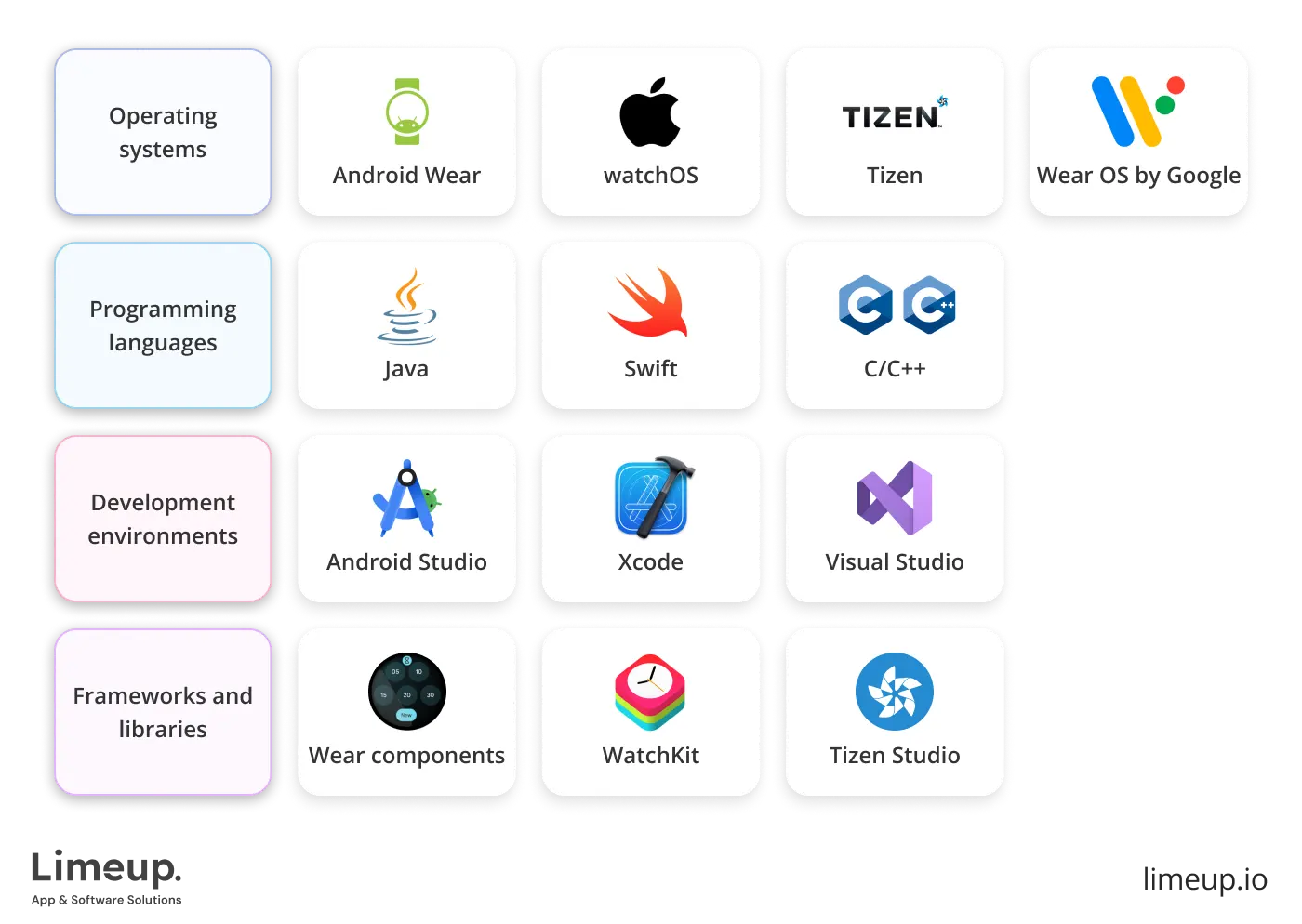
Operating systems:
- Android Wear. With the Android Wear platform, Google brings a familiar interface to its users and perfectly integrates with the Android ecosystem. The idea behind it is that it’s meant to be run on wearable devices so that we can have our apps use the existing Android capabilities.
- watchOS. As tight as its integration is with iOS, Apple’s operating system for the Apple Watch is called watchOS. It offers tools and frameworks to coders for building such an engaging user experience, such as health tracking and notifications.
- Tizen. Tizen from Samsung is used by the Galaxy Watch. Numerous features and applications are supported, catering to a broad spectrum of customer requirements.
- Wear OS by Google. It’s the rebranded version of Android Wear that is now for a broader range of wearable devices. It makes things more compatible and lets us as developers create apps that will work on different brands.
Programming languages:
- Java. Java continues to be the go-to language for Android wearable app development as it’s easily available, and for a good reason — it’s robust and versatile. But Kotlin is on the rise because of its features and conciseness.
- Swift. Swift is the major programming language for watchOS and is essential if you want to create apps for the Apple Watch. Since it’s focused on safety and performance, it’s a good choice for an application that is being used as a wearable.
- C/C++. They are used for optimization of critical tasks or when constructing custom operating systems. However, because of the constrained resources, it’s necessary for wearable devices, and with that in mind, they provide engineers with a means to do so.
Development environments:
- Android Studio. The wearable mobile app development is supported by this official Integrated Development Environment (IDE) for Android. It comes with complete tools and stuff for testing and debugging.
- Xcode. With macOS, Apple’s Xcode is the default integrated development environment (IDE) for watchOS apps. It will help you create applications more quickly by providing you with a multitude of simulators, debugging tools and more all in one interface.
- Visual Studio. It is an IDE that helps you work with Tizen application development and is a great IDE for people who want to change from another platform.
Frameworks and libraries:
- Wear components. This set of UI components and tools which you can use for sole Android Wear development so as to create visually appealing and user-friendly applications.
- WatchKit. WatchKit, Apple’s framework for iOS wearable app development, enables tech gurus to create interactive experiences aimed at the Apple Watch.
- Tizen Studio. Tizen Studio is Samsung’s integrated development environment for Tizen, which offers basic tools to build Tizen-based applications to run on Samsung wearable devices.
How to ensure security in wearable application development?
The production of trendy wearable apps is at the head of all technology innovations and some important security aspects must be covered from the base up. We have mentioned the security aspect before, but now let’s discuss it more precisely.
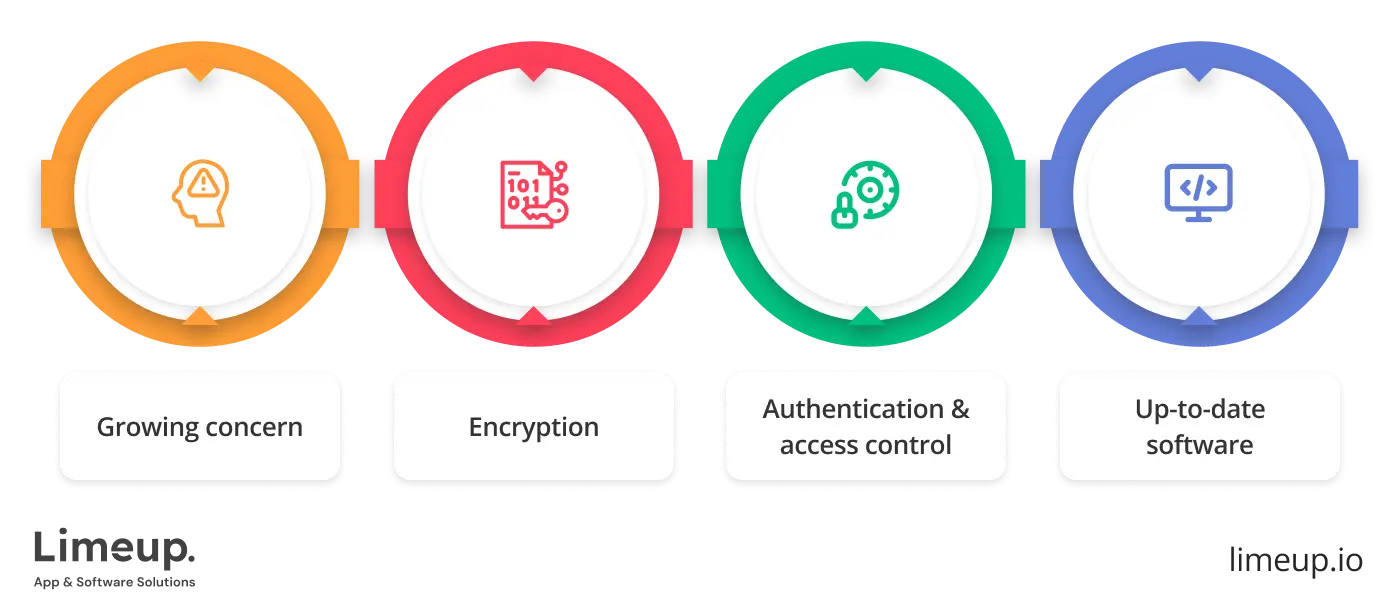
- Growing concern
Security concerns have kept up with the growth of the wearables industry. In accordance with recent statistics from the International Data Corporation (IDC) Worldwide Quarterly Wearable Device Tracker, global shipments of wearable devices increased 8.8% year over year in the first quarter to 113.1 million units, sparking a growth surge in the wearables industry that started 2024.
Wearable programs are apps that connect to the internet and multiple devices, which only create many potential vulnerabilities. While data breaches on wearable apps can be simple, there are bigger security issues.
As more companies use wearables in healthcare systems, like Apple’s HealthKit, that keep private, sensitive health data, is a concern. To avoid this challenge, hospital software companies must rise to the situation and incorporate best security practices into every app development stage.
- Encryption
The foundation for app development wearable should be encryption in order to keep data from prying eyes. Developers use advanced encryption methods, such as AES 256, to guarantee that data flowing from a wearable, the server and any connected apps are kept safe. Full end-to-end encryption adoption will protect against unauthorized access and safeguard the data in transit.
Securing Bluetooth connections, which are frequently the core of communication in wearable devices, is also important. Bluetooth weaknesses allow hackers to get into your device and poach sensitive data. The protection of the user depends on making sure that all Bluetooth connections are encrypted as well as validated.
- Authentication and access control
Encrypting and then making use of strong authentication methods is something that goes hand-in-hand quite perfectly. Similarly, multi-factor authentication (MFA) is a great way to better secure wearable apps. It leaves programmers with the opportunity to significantly reduce the risk of unauthorized access since they may require a user to verify his identity through many layers — password, biometric information or a mobile phone.
Role-based access control (RBAC) may also be implemented within wearable apps as another approach. Developers can prevent access to sensitive data by limiting it to those users with the correct role of authorization. Such measures are of particular interest when engineers develop wearable apps for healthcare and work with sensitive, critical patient data, assuring that personal health information is never put in the hands of unauthorized personnel.
- Up-to-date software
Keeping wearable apps secure always requires frequent updates. Because many attacks exploit well-known flaws, it is important to install patches and use the latest software. Cyberattacks may be avoided by installing patches, security features and bug fixes, but the upkeep of apps requires constant updates, which eventually hikes up the cost.
It’s a classic case of “an ounce of prevention is worth a pound of cure”: eliminating threats early is much cheaper than eliminating them later.
How much do wearable app development services cost?
The price to engineer a wearable app is a tricky path in an ever-changing environment, and there are many factors to consider. In contrast to off-the-shelf software, wearable solutions require complex hardware and software integration, perfect data treatment, and smooth user experience, which in turn impacts financial blueprint.
Budgets widely vary due to the size of the project and the complexity of the features and the targeted devices and thus there is no standard budget that fits all.
Organizations need to take into consideration the extent to which this app is embedded with the sensors, whether it works with a variety of wearable platforms and the degree of security and compliance necessary.
Real-time tracking or biometric information processing requires more precision, which increases development complexities. That’s why the smartest move is to collaborate with wearable technology developers who can decode the complexity and engineer efficiency.
In addition, the issue of striking balance between smart design and effective performance could further tip costs. These determinants are important in making realistic budgets, and matching the ambitions of the projects as well as the expectations of the market.
| Wearable app type | Estimated cost | Typical features included |
| Basic fitness tracker | $25,000 – $50,000 | Simple UI, basic sensor integration, notifications |
| Mid-level health monitoring app | $50,000 – $100,000 | Real-time tracking, multiple sensors, data sync |
| Advanced biometric analysis app | $100,000 – $200,000+ | Complex algorithms, multi-platform support, security |
| Enterprise-grade wearable app | $200,000+ | Custom integrations, regulatory compliance, scalability |
Factors affecting the cost
The total cost is governed by various dynamic elements in the development process. Awareness of this interplay guides smarter budgeting and resource management, giving you an opportunity to find iOS developers or Android creators for your projects without wasting resources on trial and error.
| Element | Cost influence |
| Development complexity | Sophisticated functionalities and instant data processing drive budgets upward. |
| Device ecosystem coverage | Catering to diverse wearable platforms expands scope and resource needs. |
| User experience crafting | Intricate, seamless UI designs require additional creative and technical input. |
| Server-side backbone | Scalable cloud infrastructure and robust security layers demand heavier investment. |
| Integration of external Systems | Tapping into biometric APIs or AR toolkits adds intricate engineering challenges. |
| Validation & regulatory hurdles | Comprehensive testing and strict compliance protocols extend timelines and increase costs. |
To develop a wearable app that feels intuitive in motion, teams often implement custom animations and responsive layouts that demand precision and time. On the flip side, the backend isn’t simply running in the background; robust cloud services, airtight encryption, and real-time data syncing form the backbone, and as you scale, those systems grow more complex and costly.
The integration of third-party APIs, particularly those working with sensitive biometric or location data, creates complexity which requires strict checks and response. Lastly, intense testing cycles and adherence to healthcare or data protection regulations are not only time-consuming but also specialized, hence greatly advancing budgets.
Cost optimization tips
The proper cost management process in app development for wearable devices is not about classy cheapness. Use the following strategies to tune your investment and get maximum ROI:

- Concentrate on the key functionality
An early concentration ought to be on developing the key features that bring user value directly. The implementation of secondary features can wait until the subsequent stages so the time-to-market can be shortened and the process of development can be iterative.
- Welcome modular architecture
Make your app modular. This makes it possible to implement in phases as well as make updates with relative ease, without completely replacing the system and ultimately bringing down expenses in the long run.
- Make use of the great cross-platform frameworks
Use frameworks such as React Native or Flutter to develop faster on a variety of devices and counterbalance them with the native modules that are highly dependent on their performance.
- Lay down on initial prototyping and end user testing
Test ideas prior to the actual development of them. Early comments unravel functionality/design faults that can later be costly.
- Use ready-made parts and API
Where applicable, leverage established libraries or third-party integrations as part of your wearable app development solutions to avoid reinventing the wheel. This approach accelerates development timelines and cuts costs.
- Work with niche vendors
Collaborate with the teams that worked on wearable technology before to leverage their subject expertise, streamlined work processes, and reproducible solutions.
- Be in constant integration and test automation
Make repetitive testing automated to find bugs early and minimize manual QA expenses, without disrupting the schedules.
When you combine these methods into your strategy of development, you will be able to keep costs sustainable in line with value creation, especially when partnering with cross-platform application development companies, so the wearable app investment will present sustainable and tracked returns.
Limeup’s case study: delivering a wearable solution
The goal of Raccoon.Recovery wasn’t to revise what was already there — it was to architect something fundamentally better, with Limeup as the engine. Their mission was also obvious as they wanted to enable patients to take charge of their rehabilitation journey with the help of a smart and practical bridge between physical recovery and technology, prompting them to hire Android programmers capable of building a truly responsive and intuitive solution.
We came in as the software development partner in healthcare to design an application that would integrate clinical-level accuracy and smooth UX with real-time data tracking. This was followed by a very collaborative effort leading to a next-generation wearable-driven recovery platform that is as functional as it is futuristic.
Project background and objectives
Limeup was brought in to reimagine Raccoon.Recovery’s platform from the ground up, building a wearable app that could bridge home-based care with clinical oversight, was a cornerstone of the mission.
As their partner in the development of healthcare, our mission was to integrate such features as an online instruction system and the custom assessment tool that could then be used to track the progress of a workout. These innovations are estimated to improve clinical outcomes and increase patient satisfaction to a great degree.
Important deliverables:
- Platform Design SaaS
- Mobile and Web UI/UX
- App and product Design
- Digital Health Startup Consulting
Design and development process
To drive usability among various groups of patients, our wearable app development company pursued an agile model that sprang on quick prototyping and iterative testing of users. The limited screen estate of wearables also meant that they needed a minimal and very functional UI, developed through lots of back and forth between wireframes and suggestions.
Technical execution:
- Smooth incorporation of biometric sensors to take real-time data
- Back-end system built on cloud architecture for protection of data storage
- Responsive design that optimises responsiveness and increases accessibility
- Well-articulated codebase enabling the continued addition of features
Important deliverables:
- Patient exercise management
- Recovery monitoring and recovery records
- Gamified elements, which stimulate motivation
- All-inclusive patient database and admin interface
Key challenges and how we solved them
Even the sharpest systems encounter resistance. During the wearable app development service, we broke through barriers in speed, usability, and compliance, keeping the build both lean and powerful.
- Locking & response time
It was important to process multi-sensor data streams with little latency. We built a custom middle layer fine-tuning data packets and the communication protocol, thus improving latency by an average 30% over the industry standard solutions.
- UI constraints
Complex biometric feedback was required in small-scale screens that required innovative design solutions. Using active hierarchies in the visual structure and the prioritization of content, based on the context, avoided a vexing effect on the user.
- Firewall-friendly and audit-ready
Above all, high privacy standards of the healthcare domain require high-level encryption and anonymization. We applied end-to-end encryption and multi-factor authentication, becoming 100% HIPAA compliant.
Outcome and client feedback
Tangible wins across the board: patients healed faster, clinicians had clarity, and the code held steady from dev to deployment.
The enhanced solution helped patients perform observed exercises accompanied by sensor-supported feedback which had higher recovery turns. Physicians obtained the unseen remote access to the progress of patients to intervene at the individual level.
Impact metrics:
- A quarter rise in patient compliance to prescribed exercise regimes
- Follow-up visits will be decreased by 40% because of improved remote monitoring
- Increased patient satisfaction ratings by 35% in six months after release
Raccoon.Recovery commended Limeup’s skills and teamwork, due to the fact that we could convert extensive requirements into a sleek, scalable system. The project established a base of constant innovations, and the work on the improvement is already in progress.
Latest industry trends in wearable technology
There are certain emerging trends in the wearables industry that will be significant in 2024 as they continue to progress. Below is a summary of the most important advancements in the development of wearable apps:

Health and wellness integration. Health and wellness continue to be one of the biggest driving forces in the wearable tech industry. Devices such as Apple Watch, Fitbit and Garmin have put a heavy focus around features such as heart rate tracking, sleep tracking, blood oxygen levels, etc. There has been a push recently towards more advanced health monitoring features, which are directly linked to wearable device app development.
As an illustration, it is alleged that Apple is developing non-invasive blood glucose monitoring for use in the next wearable gadget versions. We anticipate that this trend will continue to gain traction as the healthcare sector continues to embrace the usage of digital health technologies.
AI and ML on the rise. Wearable apps are about to change with artificial intelligence (AI) and machine learning (ML). To make wearables smarter, these technologies are used to analyze real-time data, learn user habits, and make personalized recommendations.
For example, a wearables-based AI algorithm would be able to monitor fitness routines and in turn offer suggestions as to how changes are to be made based on past results and user-specific analytics. Given this, we can expect AI to continue evolving in wearables, which brings us more personalized, data-driven experiences.
5G connectivity. The arrival of 5G has created new development opportunities in wearable apps. Now, wearables may carry more complex applications that could only be run on your smartphone with faster speeds and lower latency.
There are already apps that offer smoother streaming, real-time health monitoring, and better sync to other smart devices. In truth, 5G wearables make up more than just a mental concept — in the next 5 years, businesses may expect significant technical advancements thanks to 5G, as stated by over 70% of enterprises, meaning instant transmission of data and enhanced app functionality.
Wearables with Augmented Reality (AR). AR isn’t only something for smartphones and smart glasses: with wearables such as the Microsoft HoloLens and other AR-driven devices merging the physical and digital world, the rules of the game are changing for agencies developing wearable apps.
While the implementation of AR in wearable apps is still in its infancy, AR is already possible in gaming, training and navigation. Imagine you got real-time workout instructions or factory training sessions over your wearable device using AR — this is not far away.
Contactless interactions and payments. Like smartphones, payments are increasingly being made with wearables. Smartwatches and fitness trackers from companies like Apple Pay and Google Pay have now paved the way for contactless payment solutions. As wearables become more popular and the demand for cashless transactions grows, more wearable app developers will be incorporated to integrate payment functionalities into wearables.
Currently, around 30% of wearables owners use their devices to make contactless payments — that means users can make secure purchases without reaching for their smartphone.
Ready to build your next wearable app with Limeup?
In brief, the creation of apps for wearable devices appears to be more than just a fad; rather, it is a revolution that is encouraging people to engage with technology on a daily basis. The space is exploding, and developers must keep pace with trends, prioritize user privacy, and leverage yet-to-be-introduced technologies to build the most engaging, secure applications. Both vendors and consumers seem to have boundless opportunities for innovation in this arena.
Collaborating with an experienced team is necessary for the use of wearables app development as a potential in its entirety. The highly trained staff at Limeup is prepared to assist you with implementing forefront health features, improving security protocols and facilitating an uninterrupted user experience. Get in touch with us if you have any inquiries or would like to discuss your project.


